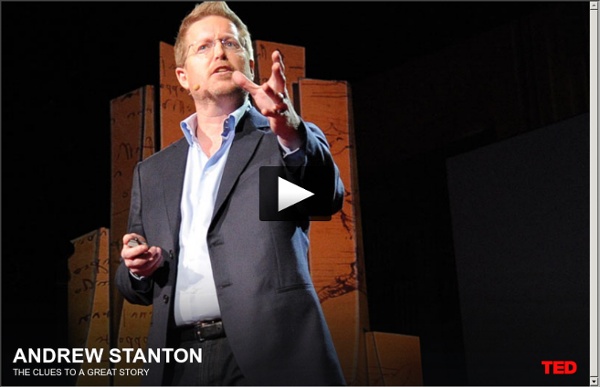



http://www.ted.com/talks/andrew_stanton_the_clues_to_a_great_story.html
Related: StorytellingHow to tell a great story, visualized A good story can make a campfire that much eerier. A good story can flip a conversation at a party from completely awkward to wonderful. Andrew Stanton: The clues to a great storyA good story can glue your nose to a book. How To Write A Novel Using The Snowflake Method Writing a novel is easy. Writing a good novel is hard. That’s just life. Wall-E and Toy Story Screenwriter Reveals the Clues to a Great Story Warning: this video contains strong language Last week we posted Pixar’s 22 Rules of Storytelling, a list of 22 golden tips first tweeted by Pixar Story Artist Emma Coats.The article received a tremendous response and since then a number of people have mentioned to us this TED talk by Andrew Stanton. Stanton was the writer for all three Toy Story movies, as well as being the writer/director for Wall-E, Finding Nemo and John Carter. In this captivating lecture Stanton talks about the early days of Pixar, storytelling without dialogue, and capturing a truth from your experiencing it. Stanton also describes being taken at age five to see the Disney’s animated classic Bambi. Of this experience he says:that’s what I think the magic ingredient is, the secret sauce, is can you invoke wonder.
Pixar’s 22 Rules of Storytelling These rules were originally tweeted by Emma Coats, Pixar’s Story Artist. Number 9 on the list – When you’re stuck, make a list of what wouldn’t happen next – is a great one and can apply to writers in all genres. You admire a character for trying more than for their successes.You gotta keep in mind what’s interesting to you as an audience, not what’s fun to do as a writer. They can be very different.Trying for theme is important, but you won’t see what the story is actually about til you’re at the end of it.
Saving Humanity from the Machine: How Storytelling Will Keep Us Human By Autumn ThatcherGuest Blog PostAutumn’s Blog The digital age has brought with it exciting transformation, but with that change comes an eerie foreshadowing of a future where human beings are dismissed and overlooked for the less expensive and faster-producing artificial intelligent counterparts that are being introduced in the workforce. The idea of human beings competing with robots sounds like something right out of a science fiction novel, but in the 21st century, these Sci-Fi fantasies are becoming a terrifying reality for those who are being pushed out of their jobs by artificial intelligence. Enthusiasts of robotic employees tout more accurate data, quicker production, and an ability to create in a way that human beings could only dream of. In 2012, Wired magazine featured an article by Steven Levy titled “Can an Algorithm Write a Better News Story Than a Human Reporter?”
The Six Main Stories, As Identified by a Computer “My prettiest contribution to my culture,” the writer Kurt Vonnegut mused in his 1981 autobiography Palm Sunday, “was a master’s thesis in anthropology which was rejected by the University of Chicago a long time ago.” By then, he said, the thesis had long since vanished. (“It was rejected because it was so simple and looked like too much fun,” Vonnegut explained.) But he continued to carry the idea with him for many years after that, and spoke publicly about it more than once. It was, essentially, this: “There is no reason why the simple shapes of stories can’t be fed into computers. They are beautiful shapes.”
New Research Indicates Fairy Tales Are Much Older Than Previously Thought – Collective Evolution We're creating a positive news network. We need your help. When you think of fairy tales, you might think of being tucked into bed by your parents and whisked away to another world as they recited a story so mesmerizing you could hear it a hundred times over. Many of your favourite fairy tales have gained so much popularity around the world that they have taken on one form or another in multiple societies. But did you ever think about where they originated from? Modern linguists and anthropologists have pinpointed the origin of most fairy tales to the time they were first written down, making them several hundred years old. “Children need art and stories and poems and music as much as they need love and food and fresh air and play. “ Wise words from Philip Pullman, who received the Astrid Lindgren Memorial Award in 2005: Children need art and stories and poems and music as much as they need love and food and fresh air and play. If you don’t give a child food, the damage quickly becomes visible. If you don’t let a child have fresh air and play, the damage is also visible, but not so quickly. If you don’t give a child love, the damage might not be seen for some years, but it’s permanent.
Kurt Vonnegut Diagrams the Shape of All Stories in a Master’s Thesis Rejected by U. Chicago “What has been my prettiest contribution to the culture?” asked Kurt Vonnegut in his autobiography Palm Sunday. His answer?